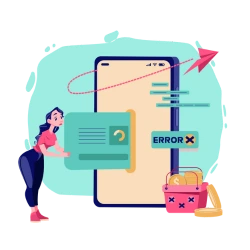If you process ACH payments for your business, you may eventually come across ACH return code R10. Automated Clearing House (ACH) payments allow businesses in the US to transfer funds electronically between banks. If the ACH network cannot collect funds from a customer’s bank account, you will receive an ACH code explaining why.
Therefore, the return of ACH funds may be a regular part of ACH processing. Returned ACH payments are due to insufficient funds, a canceled authorization, or the incorrect input of an account number. Our list of over 80 ACH return codes details why certain transactions fail.
When deciphering codes, such as an R10 return code, you must first understand the terms ODFI and RDFI.
ODFI is an acronym for Originating Depository Financial Institution. The ODFI contracts with an ACH operator, either the Federal Reserve or the Clearing House, to send bank transactions on behalf of the originator. Most major financial institutions have been ODFI-endorsed to perform ACH money transfers. Payment gateways, payment processors, and ACH payment APIs may also serve as ODFIs.
RDFI stands for Receiving Depository Financial Institution. The bank that is debited (charged) or credited (refunded) serves as the RDFI. Like ODFIs, most banks and major financial institutions have been authorized as RDFIs. The same is true for third-party payers such as the aforementioned gateways, ACH payment APIs, and payment processors.
What Does ACH Return Code R10 Mean?
An R10 ACH return code means an ACH payment was not authorized due to incorrect submission, ineligibility, or an incomplete transaction.
Formal Definition

An R10 ACH return code tells you that the receiver has not sanctioned the originator to debit the ACH account. Further, a return code R10 may reveal that the signature on ARC* and BOC** entries is not authentic or unauthorized.
*ARC stands for an accounts receivable conversion – a transaction that converts customer checks into ACH transactions.
**BOC refers to a back-office conversion – one where companies convert checks into ACH debits in the back office.
An ARC represents a single-debit entry against a corporate or personal checking account. In this case, the bank or merchant does not return checks to the customer. A BOC represents a transaction charged one time against a customer’s corporate or personal checking account.
Solutions to Fix an R10 Return Code
If you receive an ACH return code R10, stop future recurring payments and contact the customer about the failed transaction. Consult the customer as to why the payment did not go through. Doing so is the best way to resolve an ACH return code R10 complaint.
Again, if you regularly process ACH payments, you will become familiar with ACH return codes and their meanings over time. To learn more about the codes, review the list of the codes first so you can better manage checks you process through the ACH network.




